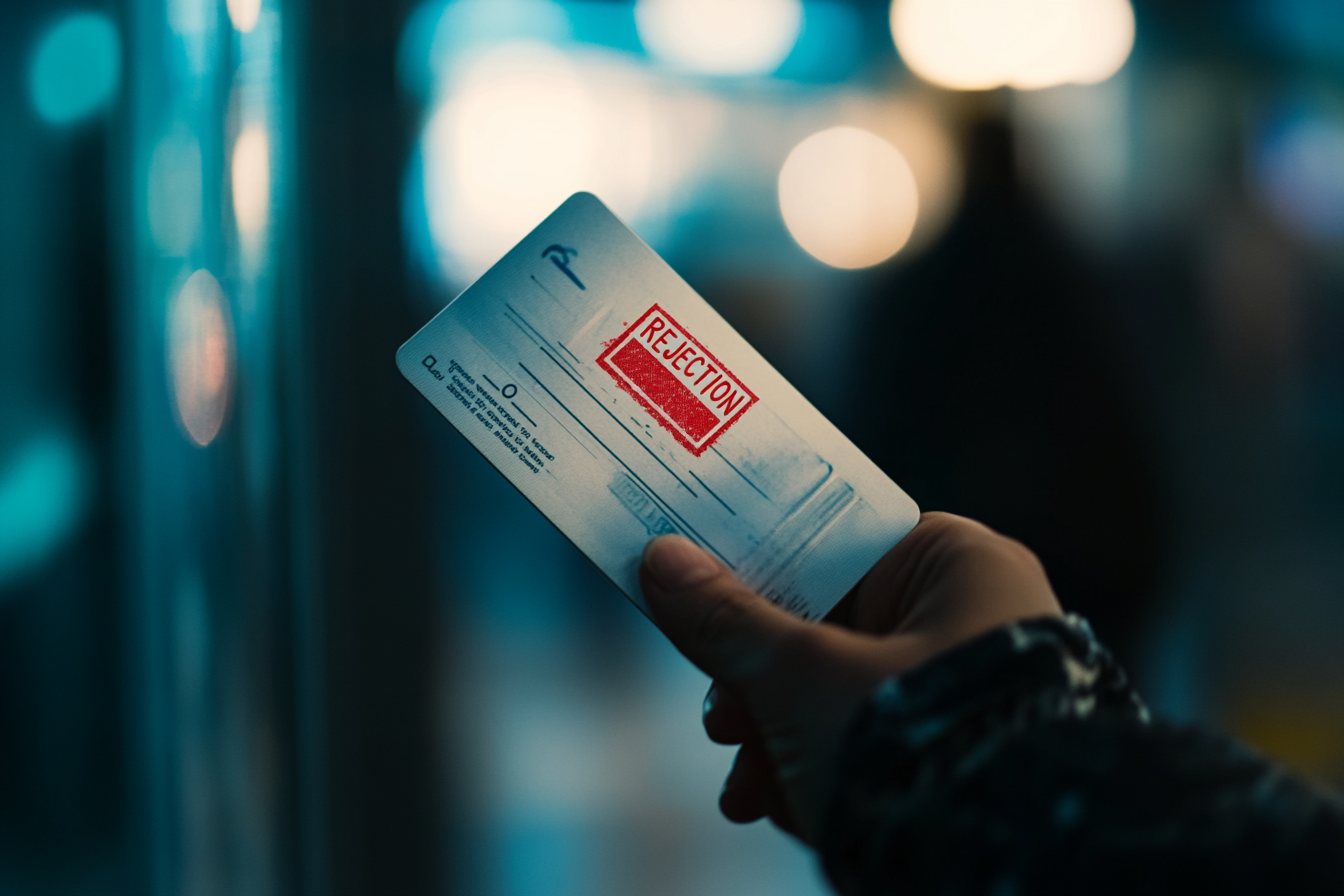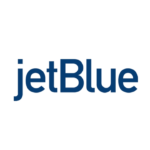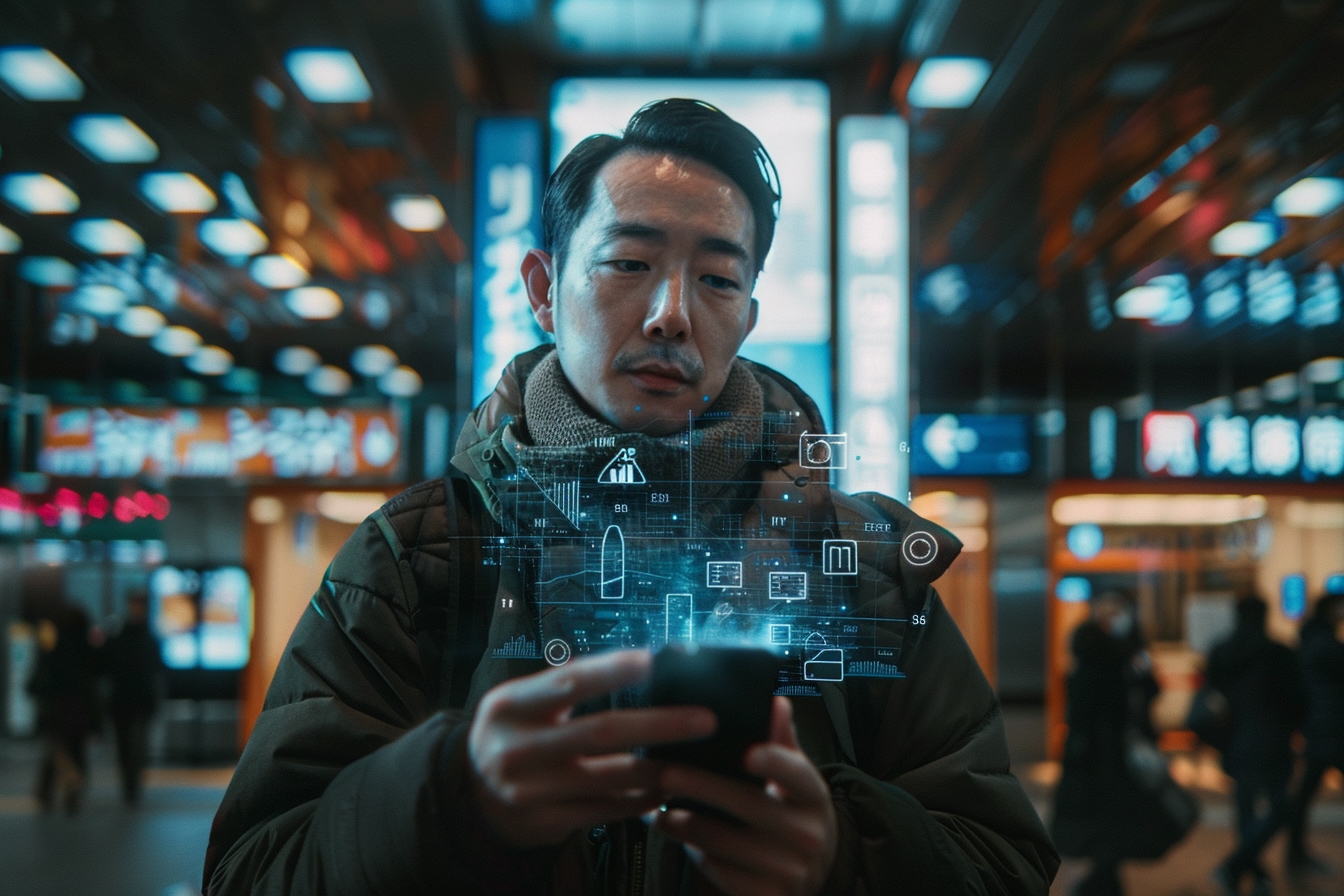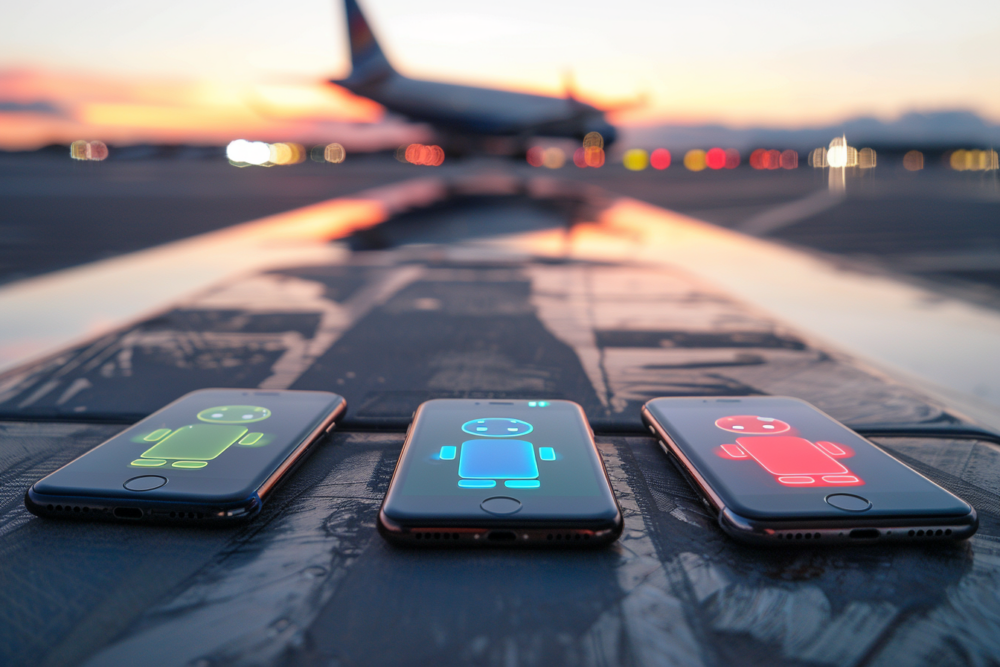The Indian travel market is booming, driven by a rapidly expanding middle class eager to explore the world.
With over 1.4 billion people, India represents one of the most significant growth opportunities for the global travel industry—particularly for Western travel brands in Europe and the United States.
But here’s the catch: many of these eager travelers never even make it to the airport.
Why? They’re stopped at the first hurdle—visa rejections.
While Western travel providers like airlines often focus on creating seamless experiences for their existing customers, they may be overlooking a critical bottleneck that prevents millions of Indian travelers from becoming loyal customers in the first place.
This is a commercial blind spot.
Visa hurdles are shutting out one of the fastest-growing travel audiences, with ripple effects on airline ticket sales, hotel bookings, and long-term customer loyalty.
In this analysis, we explore:
- Why high visa rejection rates matter more than you might think
- How innovative startups are addressing this issue with technology
- And why Western travel providers, particularly airlines, have a golden opportunity to turn this challenge into a competitive advantage
The Commercial Case for the Indian Travel Market
To fully grasp the size and potential of the Indian travel market—and other emerging markets facing similar visa barriers—let’s first look at the numbers.
With a population of over 1.4 billion, the scale of potential travelers from India is unmatched.
Yet, the vast majority of the world remains inaccessible to Indian travelers without navigating a complex and restrictive visa process.
- In fact, Indians can travel visa-free to just 50 out of 195 countries globally.
- This reality is a sharp contrast to the Western experience (as seen with countries like the U.S. in the chart below), where visa-free travel is often the norm.
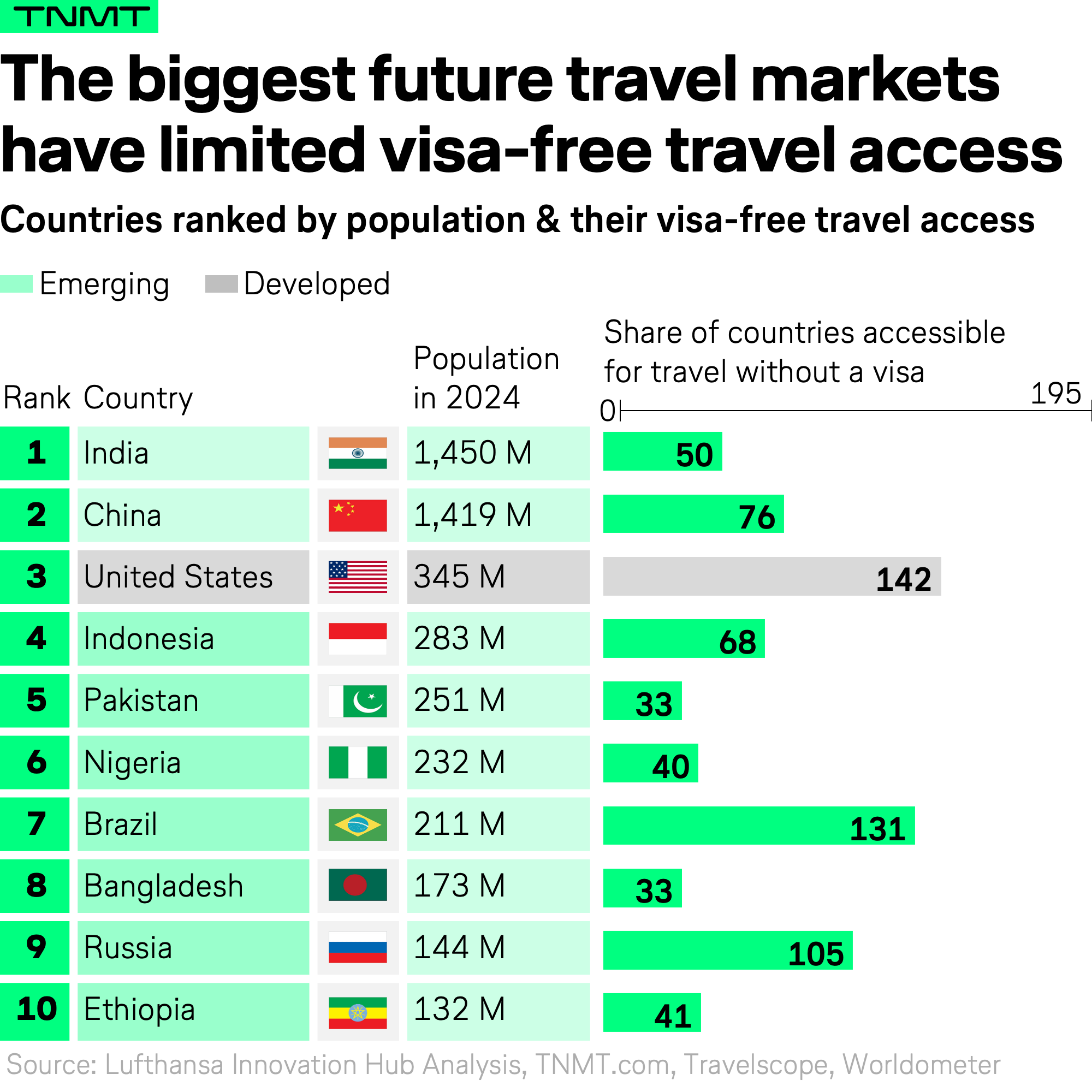
This issue underscores a glaring hypocrisy: emerging markets like India are projected to be the largest source of international travelers in the coming decades, yet they face disproportionate hurdles in accessing many of the world’s most desirable destinations, particularly in Europe and the United States.
For Western travel providers, this isn’t just a question of ethics or fairness—it’s a massive commercial oversight.
By failing to address these barriers, they risk sidelining one of the most lucrative and rapidly growing demographics of future travelers.
To understand the scope of the opportunity, consider this:
- India’s travel market is expected to rapidly outpace other emerging markets like Southeast Asia and Eastern Europe.
- By 2030, industry projections from Skift estimate India will rank as the fourth largest global travel spender.
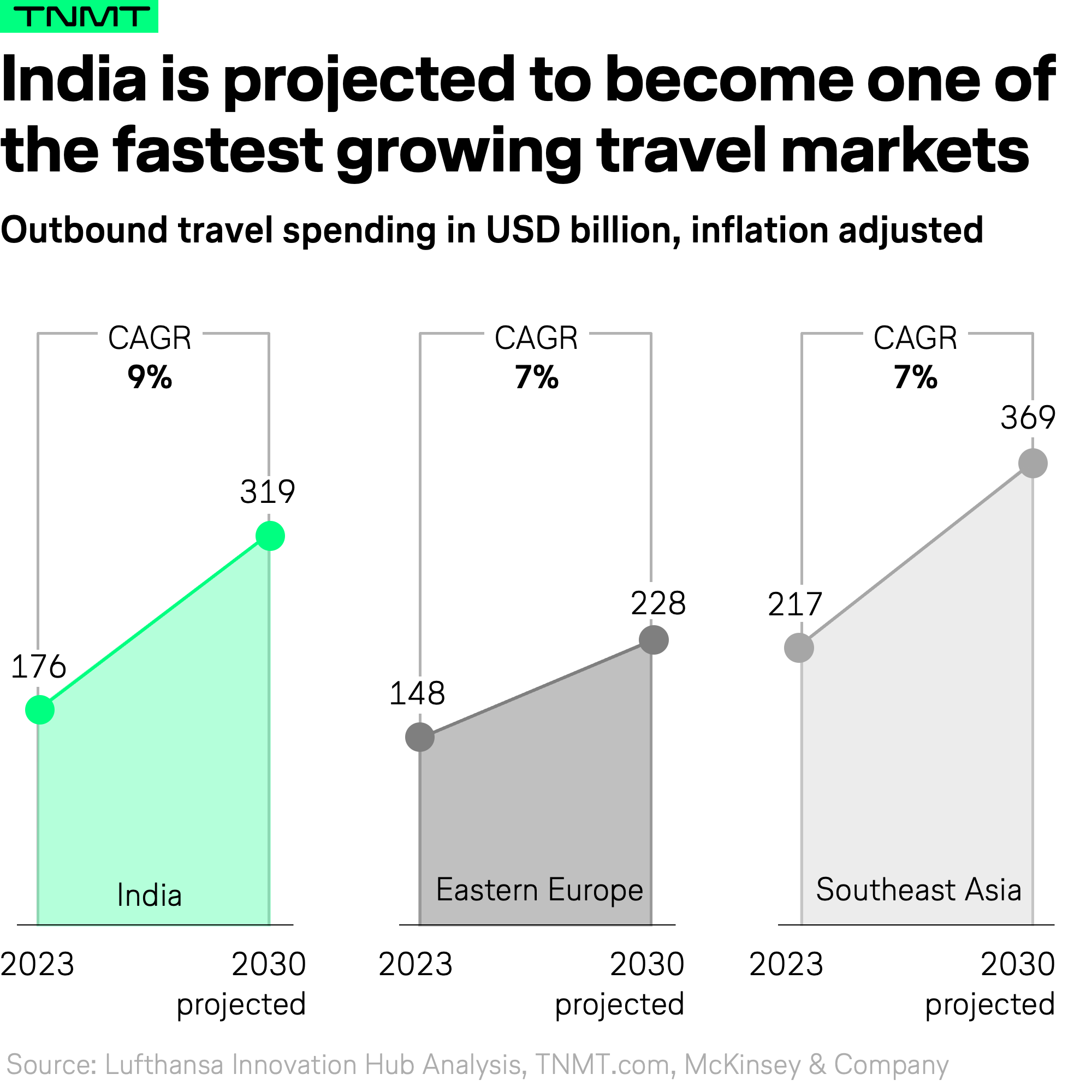
This growth is particularly striking when it comes to international travel.
The number of outbound trips from India is projected to grow more than sixfold, rising from approximately 13 million international trips in 2022 to over 90 million by 2040, according to McKinsey.
Driving this surge is the rapid expansion of India’s middle class.
- Economic growth has significantly boosted disposable income, particularly among this demographic, which now accounts for 31% of India’s population.
- By 2030, the middle class is expected to comprise nearly 40% of the population, climbing to an estimated 60% by 2050.
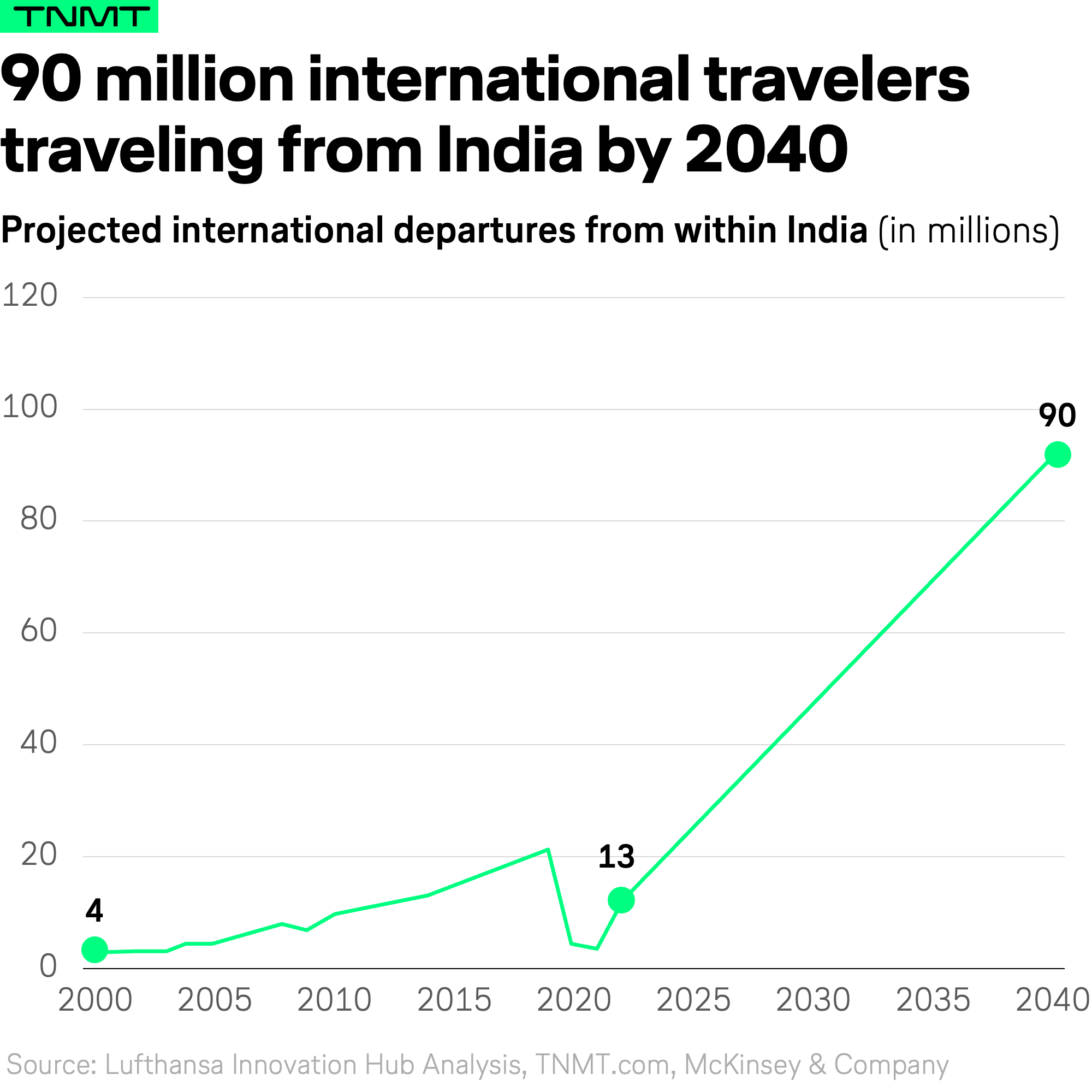
The Visa Rejection Problem: A Barrier for Indian Travelers
Despite their growing desire to travel, Indian tourists face some of the most restrictive visa policies in the world—particularly when it comes to the United States and Europe.
When it comes to traveling to the United States, for example, Indian tourists face an exceptionally high visa rejection rate, ranging annually from 25% to above 40%.
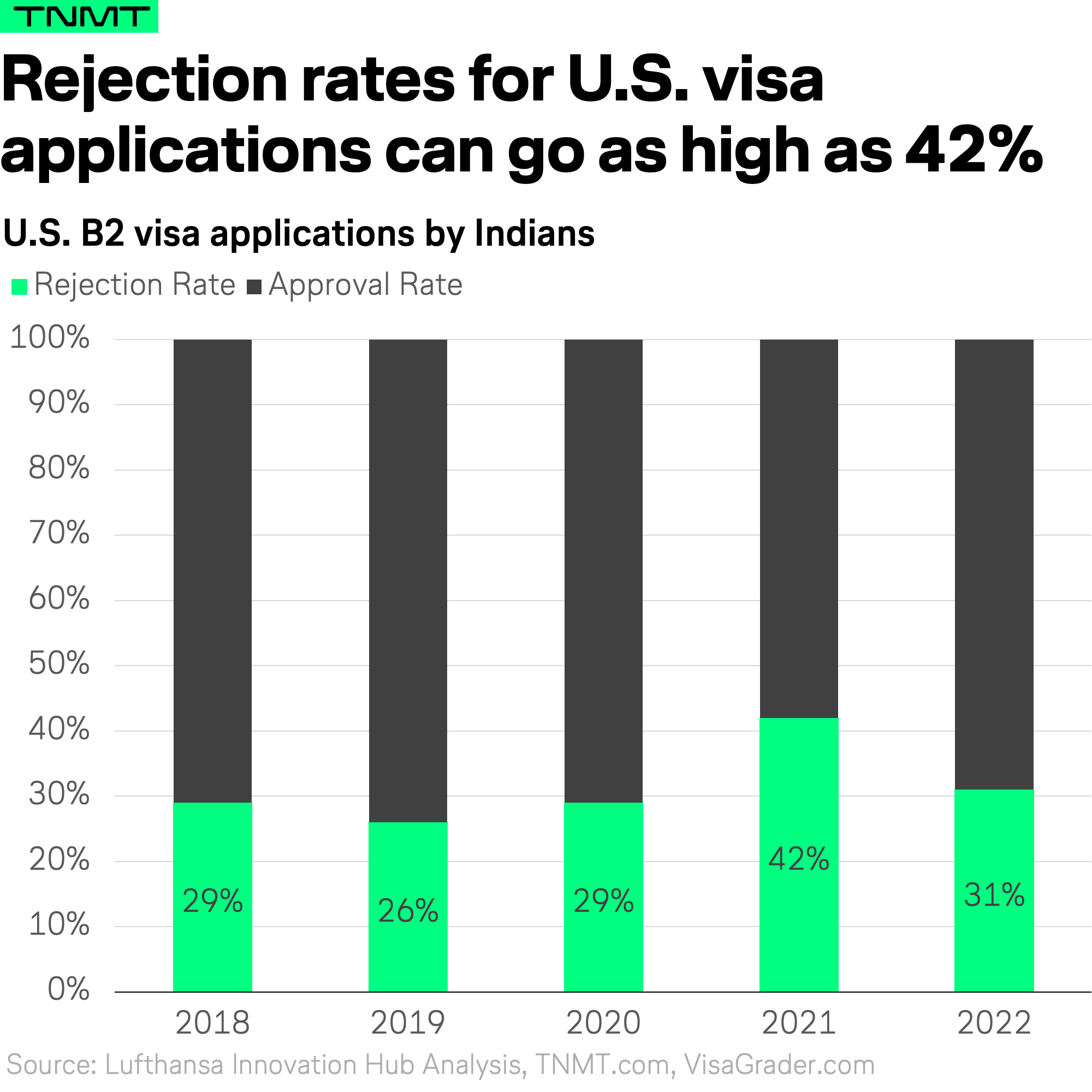
Interestingly, these restrictive policies haven’t diminished the allure of the U.S. for Indian travelers.
Quite the opposite: demand is soaring.
- In 2023, the U.S. Embassy and Consulates in India processed a record-breaking 1.4 million visas, up from 765,000 in 2022 and 276,000 in 2021.
- By March 2024, Indian passenger arrivals into the U.S. were 59% above 2019 levels.
- Midway through 2023, India even became the second-largest international source of tourist arrivals in the U.S., according to the International Trade Administration (ITA).
This surge in demand underscores a critical mismatch: while Indian travelers are eager to visit the U.S., visa policies continue to create significant hurdles.
Indian travelers hoping to visit Europe face a similar, though slightly less dramatic, set of challenges.
Visa rejection rates for the Schengen Area remain also staggeringly high, creating major bottlenecks for Indian tourists aiming to explore destinations like France, Italy, and Germany.
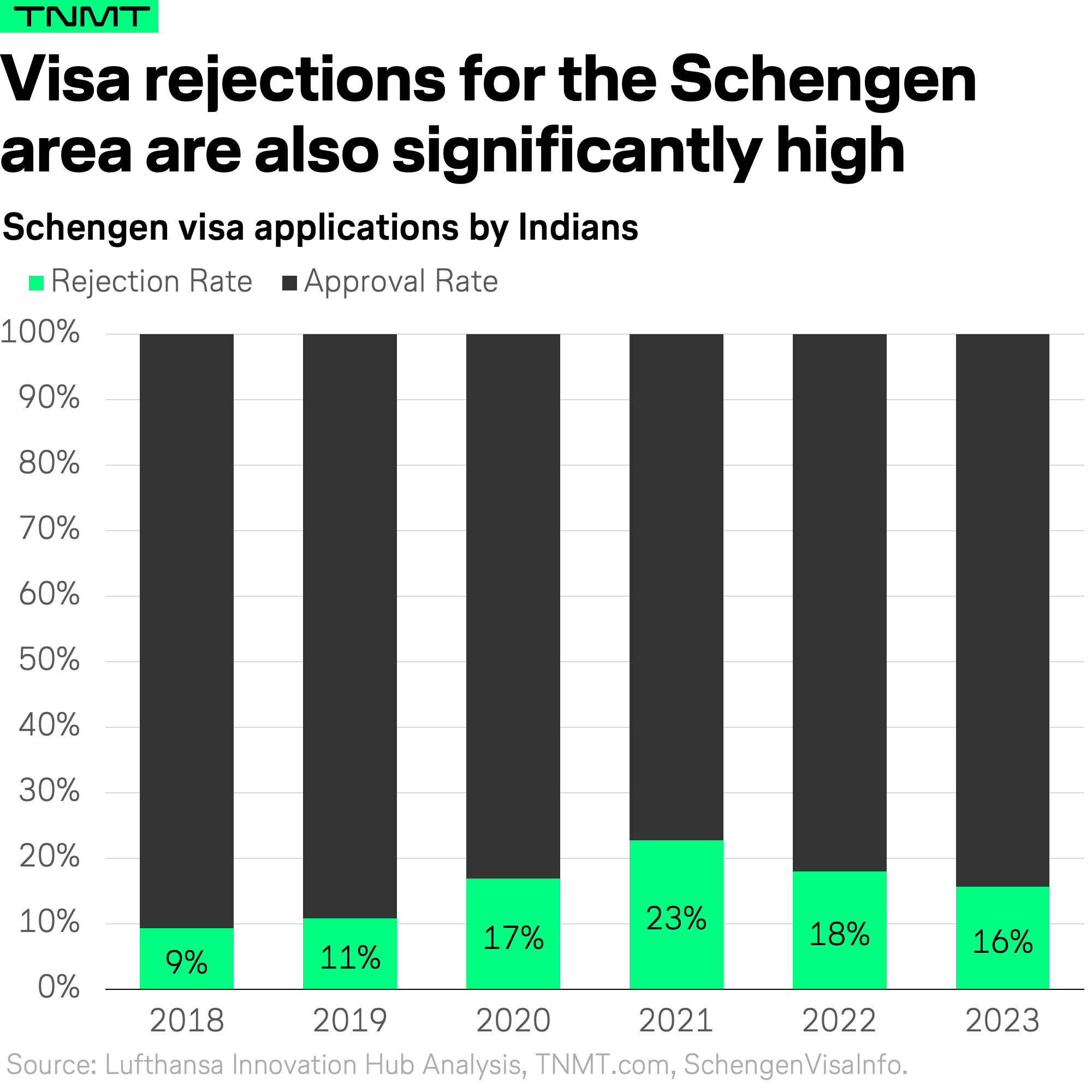
The Pain of Bureaucracy: Financial Risk in the Visa Process
Visa rejections aren’t just frustrating for Indian travelers—they’re compounded by unique bureaucratic hurdles that make the process especially nerve-wracking.
For those applying to visit destinations like the United States, the challenges begin long before their visa applications are even reviewed.
Consider U.S. visa applications:
- Indian travelers face appointment wait times ranging from six months to a year just to secure an initial visa interview.
- This lengthy delay not only disrupts travel planning but also prevents many potential tourists from even applying.
- Adding to the complexity, Indian travelers must submit proof of booked travel—such as flight and hotel reservations—before knowing whether their visa will be approved.
This requirement effectively forces Indian travelers into a financial gamble, committing significant money to travel plans without any certainty of approval.
For middle-class travelers, in particular, this risk can be a major deterrent to international travel.
The combination of bureaucratic inefficiency and financial risk creates a systemic bottleneck that not only frustrates individual travelers but also suppresses demand for international travel to the West.
The Workarounds: How Travelers Navigate Visa Rejection Risks
To navigate the uncertainty surrounding visa approvals—particularly the requirement to show proof of travel bookings—Indian travelers have developed a variety of workarounds.
While these approaches help mitigate risks, they remain far from ideal for both travelers and the travel industry.
1. Paying Extra for Flexible Tickets
The most common workaround, familiar to anyone in the airline industry, is purchasing flexible flight tickets. These tickets allow travelers to rebook flights without incurring additional fees, offering much-needed flexibility in uncertain travel scenarios.
- Flexible tickets are especially valuable for business travelers, as they provide the ability to modify flight dates and times or even secure partial or full refunds.
- However, the benefits come at a steep cost—flexible tickets are significantly more expensive than standard fares. Even when a visa is approved, travelers are left with inflated travel expenses, forced upon them by the need for flexibility.
Airlines might view flexible tickets as a financial win due to their higher price points, but they also create operational challenges. These bookings complicate demand forecasting and seat management, as they often don’t convert into confirmed travel, disrupting yield strategies. Additionally, flexible tickets limit accessibility by pricing out travelers unwilling or unable to pay significantly more than the cost of standard tickets.
The takeaway: Flexible tickets offer a safety net but remain a suboptimal solution for both travelers and airlines.
2. Dummy Tickets: A Risky Gamble
Another workaround gaining traction in recent years is the use of “dummy tickets”—temporary or fake flight reservations created solely to meet visa application requirements.
- Often priced at $10 USD or less through unregulated providers, dummy tickets offer a low-cost way for travelers to fulfill visa documentation requirements without committing to an actual booking.
- However, this workaround comes with significant risks. Embassies often reject visa applications if they suspect the dummy ticket is forged or unverifiable.
- Moreover, if the visa is approved, the originally targeted flight may no longer be available, potentially forcing travelers to pay higher prices or face complications at immigration due to mismatched flight details.
So, while dummy tickets may save money upfront, they introduce considerable uncertainty, turning what seems like a quick fix into a gamble that can complicate the travel process further.
3. Travel Insurance: Limited Protection Against Visa Rejections
The third workaround is purchasing “classical” travel insurance, though its effectiveness is limited when it comes to visa rejections.
- Standard travel insurance policies usually cover general travel disruptions, offering some financial relief for travelers.
- However, most travel insurance policies do not cover visa rejections, leaving travelers unprotected against the financial loss of non-refundable bookings.
- Specialized “visa rejection insurance” products aim to fill this gap but require careful review of policy terms to ensure that visa-related risks are explicitly included.
In summary, all three current workarounds offer only partial solutions to the risks associated with visa rejections. They come with undeniable drawbacks, including high costs, operational inefficiencies, and financial uncertainty.
Innovative Solutions: A New Era in Tackling Visa Rejections
What we have learned so far: Traditional workarounds for visa rejections are far from ideal.
Fortunately, a growing number of emerging tech-driven solutions are beginning to address the issue more effectively.
- These offerings not only mitigate the pain points for travelers but also provide valuable lessons for Western travel providers seeking to tap into this market.
- Below, we have mapped five standout approaches, each offering a unique take on tackling the visa rejection challenge:
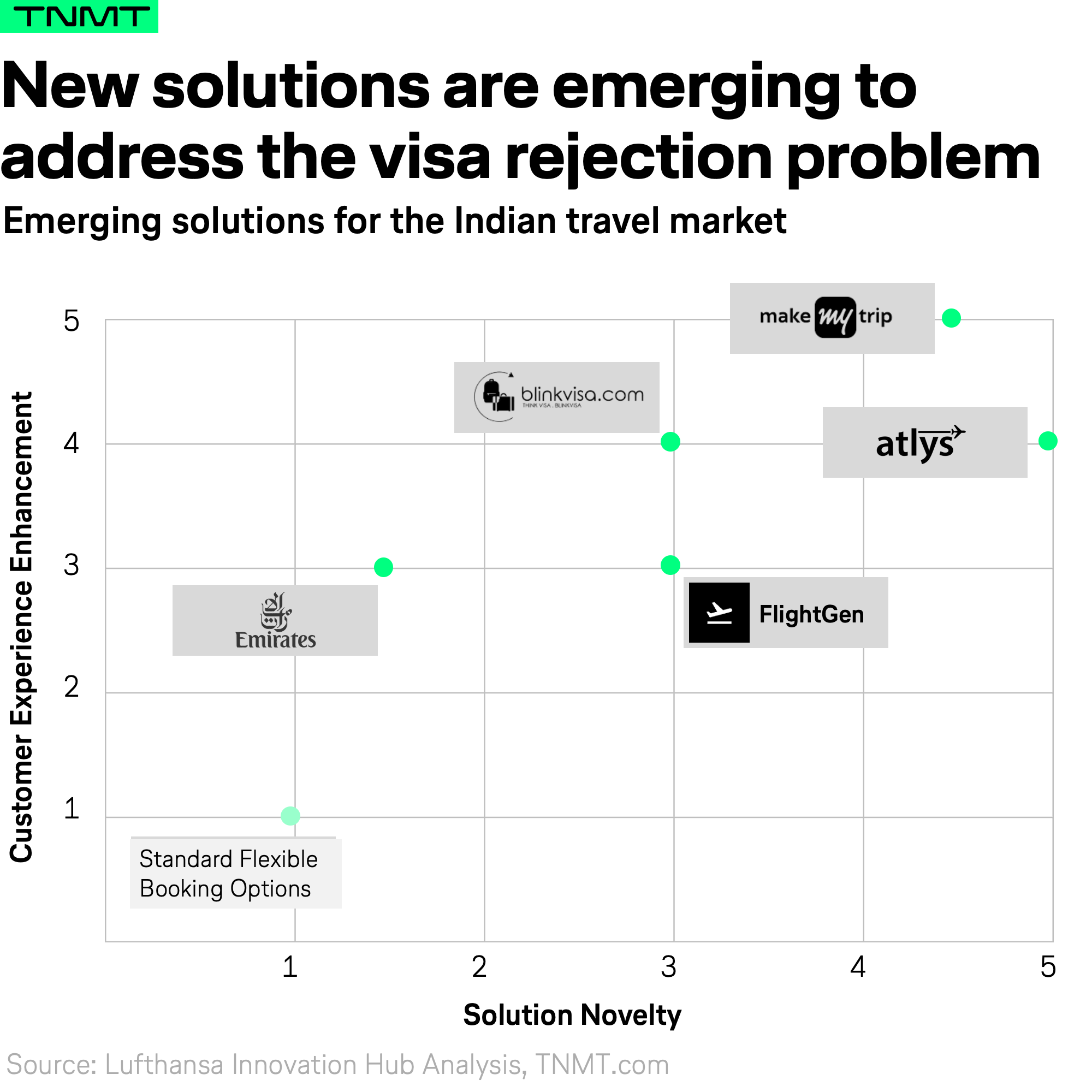
Let’s explore these solutions one by one in a bit more detail.
1. MakeMyTrip: Specialized Insurance Against Visa Rejections
Indian travel OTA MakeMyTrip has demonstrated a deep understanding of local traveler challenges by integrating visa rejection insurance directly into its booking platform.
- This solution provides travelers with a financial safety net, ensuring refunds for flights in eligible cases of tourist visa rejections.
- By bundling this insurance seamlessly with flight bookings, MakeMyTrip simplifies the process and enhances user confidence.
The policy covers up to nine passengers under a single booking and supports both e-visas and traditional visa applications. Affordable pricing makes it particularly appealing to budget-conscious travelers.
However, the policy does come with limitations.
- Coverage is restricted to the original flight schedule, meaning any airline-initiated cancellations or schedule changes render the policy void.
- Additionally, the policy does not cover delays in visa processing—a common issue—and applies solely to tourist visas, excluding other travel purposes like business trips.
Despite these drawbacks, MakeMyTrip’s offering stands out for its seamless integration, providing a strong example of how local expertise can address niche traveler concerns effectively.
2. Atlys: AI-Powered Visa Application Support
San Francisco-based startup Atlys has taken a technology approach to tackling visa application challenges by leveraging artificial intelligence.
- Atlys uses an AI-powered evaluator to assess the likelihood of visa approval, offering personalized feedback and actionable recommendations to travelers.
- This approach helps applicants identify potential weaknesses in their submissions, improving their chances of success.
The platform is designed to reduce the stress and uncertainty associated with visa applications, making it particularly appealing to first-time international travelers. Uniquely, Atlys only charges a fee once the visa has been successfully issued, further enhancing its appeal.
While Atlys does not guarantee visa approval, its ability to improve application quality demonstrates how technology can empower travelers and address long-standing inefficiencies in the process.
3. BlinkVisa: Cashback on Visa Fees
Bengaluru-based BlinkVisa offers another creative approach to easing the financial burden of visa applications through its cashback model.
- Travelers who apply for visas through BlinkVisa receive 100% cashback on their visa fees in the form of travel credits, which can be used to offset costs for flights, hotels, or activities booked through the platform.
- This model ties seamlessly into BlinkVisa’s broader ecosystem of travel planning, making the visa application process more appealing and cost-effective for budget-conscious travelers.
However, this solution is not without its drawbacks either.
- The cashback can only be used within BlinkVisa’s platform, limiting its flexibility.
- Additionally, travelers must still pay the full visa application fee upfront, which may deter many users.
Despite this, BlinkVisa’s unique approach emphasizes how financial incentives can make the visa process less daunting.
4. FlightGen: A Safer Alternative to Dummy Tickets
FlightGen, another mobile app solution, addresses the aforementioned workaround used by many Indian travelers: dummy tickets, however, in a slightly smarter way.
- The platform simplifies the dummy ticket practice by providing authorized flight itineraries for visa applications, significantly reducing the financial risk associated with non-refundable bookings.
- FlightGen’s service allows travelers to submit proof of travel without committing to costly flight tickets, making the visa application process more accessible.
- For frequent travelers, FlightGen offers subscription options that further enhance its value proposition.
However, the solution focuses solely on fulfilling documentation requirements rather than addressing the root causes of visa rejections.
Additionally, there is no security that all embassies and consulates will accept their temporary itineraries, which limits the platform’s effectiveness.
5. Emirates: Streamlining Visa Processes for Select Travelers
Emirates, the only airline on our list, has taken a proactive approach to simplifying visa requirements, even though on a limited scale.
- The airline facilitates pre-approved visas for Dubai-bound Indian travelers who hold valid residency permits for the U.S., UK, or EU.
- This initiative significantly reduces wait times and ensures a smoother experience for eligible travelers, allowing them to bypass queues and expedite customs clearance upon arrival in Dubai.
However, the initiative’s scope is narrow, catering exclusively to Indian passport holders with specific residency credentials. As a result, many travelers remain excluded from this streamlined process.
Turning Challenges into Opportunities: A Call to Action for Airlines
All these emerging solutions illustrate how creative thinking and targeted strategies can help address the visa rejection pain point in more meaningful ways.
While none of these approaches fully resolve the systemic issues (yet), they provide valuable lessons for the travel industry on how to better serve emerging markets like India.
With India’s outbound travel market poised for exponential growth, the time is ripe for airlines to address this critical pain point as well and position themselves as enablers of seamless international travel.
Integrating solutions like visa rejection insurance into their service portfolios could be a first initiative.
- By forming partnerships with innovative startups or insurance providers, airlines can offer travelers a layer of financial security that addresses one of their biggest anxieties.
- This would not only differentiate airlines from competitors but also build long-term loyalty among a rapidly expanding and increasingly influential demographic.
The beauty of such an approach lies in its inclusivity and scalability.
Visa rejection insurance, for example, isn’t just for travelers with a high risk of rejection—it caters to the uncertainty every traveler faces during the visa application process. This ensures a broad appeal across customer segments, maximizing impact.
Moreover, from an airline’s perspective, implementing these services represents a low-risk, high-reward strategy. Compared to more capital-intensive innovations, these partnerships require minimal investment while offering significant returns in customer trust, satisfaction, and repeat business.
For airlines, the message is clear: failing to address these barriers risks alienating one of the fastest-growing outbound travel markets in the world.
But those willing to innovate and meet the needs of Indian travelers stand to gain not only market share but also lasting brand equity in one of the most promising travel markets of the future.
This article was developed with research and insights support from Dhvani Shah, Research & Intelligence Intern at Lufthansa Innovation Hub Asia.


